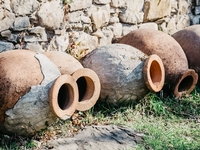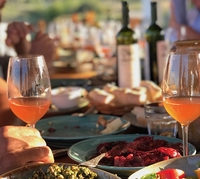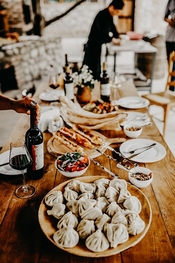 running wine tradition with wines fermented and aged in clay qvevri, over 525 indigenous grape varieties, and stunning landscapes with the Caucasus Mountains to the north and the Black Sea to the west.
running wine tradition with wines fermented and aged in clay qvevri, over 525 indigenous grape varieties, and stunning landscapes with the Caucasus Mountains to the north and the Black Sea to the west. A new generation of Georgian winemakers is preserving the old winemaking traditions while bringing new life and energy to the wine industry and propelling it forward to keep up with today’s growing demand.
To learn more, I crafted a few questions for and connected with several Georgian wine experts regarding the Georgian wine revival and why everyone should be drinking these unique wines from one of the world’s most diverse winemaking areas.
Miranda Franco (MF): What can Georgian wines offer to wine lovers that they can’t get from another bottle?
Julie Peterson, Managing Partner, Marq Wine Group: Georgian wine is – literally – unique. First, Georgia is the archaeological birthplace of wine. Second, Georgia originated and still uses a now UNESCO and PGI (Protected Geographical Indication) qvevri winemaking method. Qvevri are large, hand-made, roughly egg-shaped clay vessels – 1,000 or more liters – buried up to their necks to keep temperatures constant during fermentation and aging. In the traditional method, winemakers ferment the juice and skins together, and the skin contact turns what would otherwise be white wines into amber wines with tannins. Third, tiny Georgia is home to 525 indigenous grape varieties; by comparison, France is four times larger and has only half that number of indigenous grapes. Finally, while this is not unique, it is rare: Georgia is one of the world’s 36 biodiversity hotspots, with climates ranging from sub-tropical to Alpine and an equal array of soils.
Sasha Burekovica, Founder, and Alex Davis, DC/VA District Manager, Terraneo Merchants: Georgian wines made in the traditional quevri style simply don’t have analogs anywhere else in the world. They are terroir in their purest sense, and it’s really interesting to pour a glass of Kisi and consider the fact that Georgian wine hasn’t changed a considerable amount over the last few thousand years.
Michael Kabilnitsky, President, Corus Imports: Georgia offers unique wines with 525 indigenous known grape varieties and about 45 of them used in wine production. Adding to that is traditional Georgian winemaking in qvevri.
Noell Brockett, President, Georgian House of Greater Washington: A deep connection to both an ancient past but also to a thriving community of pioneering winemakers who are striving each day to preserve their traditions and develop a new future. It reminds you that wine is humanity’s constant companion, and it can really bring the spirit alive when appropriately nurtured.
MF: How does Georgia’s history as the “cradle of wine” impact the winemaking community?
Julie Peterson, Managing Partner, Marq Wine Group: Wine is truly central to Georgian identity, again with the triumph and continuity of qvevri winemaking having almost mythological status in the face of the many invasions the country has withstood; even today, the Russians regularly encroach on Georgia’s borders, just a few meters every night in a slow, steady, threatening advance.
The familial nature of wine strikes anyone who visits Georgia: everyone from the very young to the very old is involved in winemaking. The way most Americans can make a hamburger, most Georgians can make wine. Almost every evening meal involves toasting and wine. Nearly every religious ceremony involves a shared cup of wine. One comes away feeling that countries like France and Italy are only very casual about wine, while for the Georgians, it is central to life.
Although history has not made it easy for Georgians, they continuously and vigorously protect their autochthonous grapes and winemaking techniques. Under the most recent Soviet occupation, industrial winemaking was mandated, yet the Georgian family wineries prevailed. For Georgians, wine is a key to their culture.
Sasha Burekovic, Founder, and Alex Davis, DC/VA District Manager, Terraneo Merchants: The Georgians are famous for the pride they take in their wines. Vines have been used on flags and sigils in Georgia for millennia, and it’s a hugely important component of the Georgian identity. For all of the work the Georgian winemaking community has done to preserve and elevate the uniqueness of their wines, it’s incredible to see them beginning to show up on shelves and wine lists all over the world.
Michael Kabilnitsky, President, Corus Imports: The fact that Georgia is officially the Cradle of Wine attracts attention from both consumers and professionals.
Noell Brockett, President, Georgian House of Greater Washington: The  most important thing is that it birthed a living tradition. In other words, it produced the context in which every Georgian feels comfortable, confident, and even expected to make wine. This culture then provides a rich soil in which spectacular and unique winemakers can thrive. As Georgians say, “Our Blood is Wine,” which is to say that Georgia’s love affair with the grapevine is simply unparalleled, and they have 8000 years of history to prove it.
most important thing is that it birthed a living tradition. In other words, it produced the context in which every Georgian feels comfortable, confident, and even expected to make wine. This culture then provides a rich soil in which spectacular and unique winemakers can thrive. As Georgians say, “Our Blood is Wine,” which is to say that Georgia’s love affair with the grapevine is simply unparalleled, and they have 8000 years of history to prove it.
Peterson: Georgia’s most widely known varietals are, in a hold-over from the Russian imperatives, Saperavi and Rkatsiteli. Yet, there are 523 other varietals to discover, about 40 of which are fairly commonly produced. Georgia’s most widely grown white variety is Rkatsiteli which makes up 60 percent of all grapes grown in Georgia, whether white or red; after that, the most commonly vinified white grapes are Mtsvane, Chinuri, Kisi, Tsitska, and Tsolikouri, which are all well-worth tasting! The most widely grown red is Saperavi; others include Takveri, Shavkapito, Chkhaveri, Ojaleshi, Aleksandrouli, and Aladasturi.
Using four lesser-known white varieties as examples of what to try, Mtsvane – which translates to “green” – is native to Kakheti, the easternmost winegrowing region in Georgia, which has limestone, alluvium, and sandy soils. Mtsvane is loved for its fruity and aromatic characters. Another delicious white variety from  Kakheti is Kisi, a hybrid of Mtsvane and Rkatsiteli, which typically has ripe pear, tobacco, marigold, and walnut – the latter two of which are common ingredients in the cuisine of that region. From the west of Georgia, from the Imereti region, two well-known whites are Tsolikouri and Tsitska. These are grown in the region’s heavier clay soils, with lower pH. Both are aromatic, floral, and white with high acidity that expresses incredible freshness; they make delicious still wines and are commonly blended to make sparkling wines.
Kakheti is Kisi, a hybrid of Mtsvane and Rkatsiteli, which typically has ripe pear, tobacco, marigold, and walnut – the latter two of which are common ingredients in the cuisine of that region. From the west of Georgia, from the Imereti region, two well-known whites are Tsolikouri and Tsitska. These are grown in the region’s heavier clay soils, with lower pH. Both are aromatic, floral, and white with high acidity that expresses incredible freshness; they make delicious still wines and are commonly blended to make sparkling wines.
Some delicious emerging reds are Chkhaveri, Aladasturi, and Ojaleshi. Chkhaveri, native to Guria, is a red grape with pink skin that produces rose-colored wine even when vinified as a red (e.g., on the skins). This grape is round, juicy, thin-skinned, and leans toward higher acidity, producing soft, balanced wines with moderate alcohol levels and a wide range of aromas and flavors. Aladasturi – which translates as “Allah said yes” – is a dark-skinned variety grown in Imereti; it is mostly used to make semi-dry rosé wines but produces stunningly beautiful still reds that are worth seeking out. Ojaleshi, from the area surrounding the Tskhenis-Tskali River in the northwest of Georgia – in the Lechkhumi winegrowing region – is often vinified semi-sweet and makes stunning dry reds; the flavors are usually reminiscent of rosemary, lavender, berries, and spice.
Kabilnitsky: Ojaleshi, Tetra, Mukhamtsvane, Chitistvala, Kundza, Danakharuli, etc.
MF: What are some gateway wines for those beginning their curious exploration of Georgian wines?
Peterson: Deep in fruit character, low tannin, yet brisk with acidity, Saperavi is a classic, indigenous Georgian variety which is a great first choice for consumers exploring Georgian wine. It can be a lighter, more fruity wine which makes a great alternative to Merlot, or when made using other methods, can have a weight that mimics Cabernet Sauvignon. In Georgian, Saperavi means “to dye,” and it is one of the 14 teinturier grape varieties globally, meaning a grape with red flesh and red skin. Saperavi wines have a deep, luscious, and often fully opaque color. The aromas and flavors are typical of dark berries, licorice, grilled meat, chocolate, and spices.
Saperavi is made in various methods, including in qvevri, tanks, barrels, and sometimes a combination of methods. It is generally used as a still wine, though there are also rosé and even some sparkling Saperavis to be found.
Kabilnitsky: Tsinandali, Mukuzani, Tsolikouri, Kindzmarauli, Tvishi, and light Amber wines, with skin contact between 2 and 4 months. Traditional six and more months of maceration may result in a style too hard for novices to understand.
Burekovic and Davis: There’s a reason that Saperavi and Rkatsiteli are the most popular Georgian varietals. Definitely start with these if you’re new to Georgia, and you can go very deep down the rabbit hole from there if you get hooked.
MF: What Georgian wines should seasoned oenophiles explore?
Peterson: As mentioned, there are hundreds of indigenous amber wines to try. Oenophiles usually start exploring wines from Kakheti – which are heavier and more robust – then work their way westward to the lighter styles.
Brockett: Start your Journey with Teliani Valley, explore Dila-o, Orgo and dive deeper into Baia’s Wine, Tevza, and get exotic with Kereselidze Wine Cellar, Chona’s Marani, and Rosha Winery.
Kabilnitsky: Professionals are getting more and more in the know about Georgian varieties, and some know more than others, so they should explore the wines that they’ve never tried before.
Burekovic and Davis: While most Georgian wines are varietally-labeled, there are some fantastic blends being made as well, some of which have their own appellations. Chinebuli is a blend of Chinuri and Goruli Mtsvane that we find very underrated. There’s also Khidistauri, which takes those two grapes and introduces Tavkveri, making the resulting wine a light red very conducive to a light chill
MF: Does the language barrier/pronunciation of native grapes serve as a barrier to get consumers to try Georgian wine?
Peterson: The Georgian language is fully unique: it is not part of any of the world’s language trees. That being the case, it truly is foreign to most people, even those who can feel their way through the more familiar Latin and Germanic languages. The English “version” of Georgian is written with a lot of consonants, which make reading – let alone pronunciation – intimidating at first and make memorization and retention fairly difficult. However, there are easy initial names to hold onto, and even the most complex words become easier over time.
In addition, Georgian wineries put a huge amount of effort into educating the trade and the public, as does the Wines Georgia campaign. In the last five years, labels have evolved mightily to convey useful information in English. This is also helped by the younger generations in Georgia, as nearly all of them speak very good English.
Globalization has lessened the language barrier, allowing the foreign to be enticing rather than confusing.
Brockett: Some of the varieties are mouthfuls! But for Georgia, there is no other way. Rkatsiteli, Saperavi, Mtsvane, Tsolikouri, Chinuri are the varietals that have grown with them for thousands of years, and Georgians are loyal and faithful people. You dance with the ones that “brung ya.”
Kabilnitsky: Yes, very much so. The Georgian language is very different from western European languages, and sometimes the words are tongue twisting.
Burekovic and Davis: It definitely shouldn’t, and I think as Georgian wine starts to become more ubiquitous in the states, it certainly won’t. It’s part of our job on the supply side, whether we’re importers or sommeliers or running a wine shop, to familiarize our customers with new things. So, while it might take a couple of attempts to pronounce something correctly, the same can be said for grapes from France or Germany just as much. And if you’re ever in doubt, ask a Georgian!
MF: What has been the biggest improvement in Georgian wines over the last ten years?
Peterson: The National Wine Agency of Georgia works to preserve the country’s qvevri winemaking tradition, control the quality of all Georgian wines, and promote Georgian wines globally. In 2013, the United Nations added qvevri winemaking to the UNESCO list of humanity’s intangible cultural heritage. In 2020, the International Organization of Vine and Wine (OIV) named Georgian amber wines the 8th “wine type” category. Earlier this year (2021), qvevri became the first non-agricultural product to ever be added to the Georgian Registry of Protected Geographical Indication (PGI). This legally established Georgia as the place of origin for qvevri and codified the shapes, capacities, raw materials, and production methods that can be used. All of these have further increased demand for Georgian wine, as well as raised its value, and facilitated the global promotion of Georgian wine.
In addition, the quality and stability of the wines improve year after year. My first trip to the region was in 2015, and there was great variation in the consistency of quality of the wines, especially for international shipping. Now, just six years later, things are vastly different. We held a trade tasting last week, at which we had a table of 118 wines looking for importers. We had never before opened or tasted most of those wines; out of the 118, I’d say only four had an issue, which would be in the normal to low range for imported wine. So, the U.S. market interest in and demand for quality wines from Georgia has noticeably pulled Georgian winemaking forward.
We also see the difference on the ground in Georgia. In the U.S., the median annual income per capita is $57,000. In Georgia, it’s $400.00. They are providing access to the U.S. market matters, as does growing Georgia’s wine presence here. For example, due to this growth, we’ve seen winemakers be able to plant new vineyards, as well as upgrade their maranis (cellars) or build new ones. Every bottle of Georgian wine sold truly makes a difference in the lives of the winemakers and their families and the qvevri-makers’, the guides, the truckers, the local community, and so on so forth. Wine is the fourth largest export from Georgia, following only copper ore, iron alloys, and automobiles. Wine grapes are the country’s second-largest agricultural crop.
Burekovic and Davis: In the last ten years, Georgia has experienced a renaissance of traditional Georgian winemaking. Overall quality has improved, and artisan producers are slowly growing and expanding their presence in Georgia and abroad. Vineyards have been replanted with rare indigenous sort, and a growing interest in kvevri wines from abroad has enabled small producers to start new projects and expand old ones.
MF: Is having 525 plus indigenous varieties a blessing or a curse?
Peterson: It’s absolutely a blessing! Georgia is home to more than 525 varieties of indigenous grapes—roughly one-sixth of the world’s total grape varieties. This incredible biodiversity is a gift in terms of disease resistance and is proving to be a boon in the face of climate change.
There are wonderful living vine libraries to visit in Georgia: the Georgian government sponsors a centralized vine library, called the National Grape Collection, at the LEPL Scientific-Research Center of Agriculture in Jighaura, just north of Tbilisi. Their vineyards and nurseries contain 437 varieties of native Georgian grapevines, along with 350 non-Georgian varieties. Researchers study the indigenous varieties to understand better their origins, grape characteristics, and disease resistance, among other topics. The goal is to rediscover and identify lost Georgian grapes and discern the best candidates for producing quality wines. Private wineries also have wonderful “living museum” nurseries: the one at Shumi Winery in Kakheti is of particular note.
Kabilnitsky: In my opinion, it’s a blessing. Currently, there are only about 45 varieties used in commercial wine production, but more are getting restored from the past and made available to producers every year.
Burekovic and Davis: Having 500 plus indigenous varieties is a huge advantage and blessing for Georgia. The Georgians saved these ancient varieties despite numerous invading empires devastating their lands and vineyards. The Persian empire, the Ottomans, and most recently USSR all had a substantial negative impact on the Georgian wine industry but also showed the perseverance, strength, and stubbornness of the Georgian people, who saved their language, alphabet, culture, and indigenous vines despite the turbulent history.
Peterson: For retailer and restaurant information, please visit the Wines of Georgia website.
Kabilnitsky: We have our Corus Imports website, we advertise on social media platforms and radio, participate in promotional events and expos, conduct consumer tastings in stores and restaurants.
Davis: We can be found throughout D.C. and Northern Virginia. For the broadest retail selection, people should check out Batch 13 or Domestique. On the restaurant side, for those in the DC/VA area, we can be found at Reverie, Maydan, Queen’s English, and Oyster Oyster among many fantastic others. If sommeliers or wine buyers are interested in our Georgian wines, I can be reached at [email protected]
